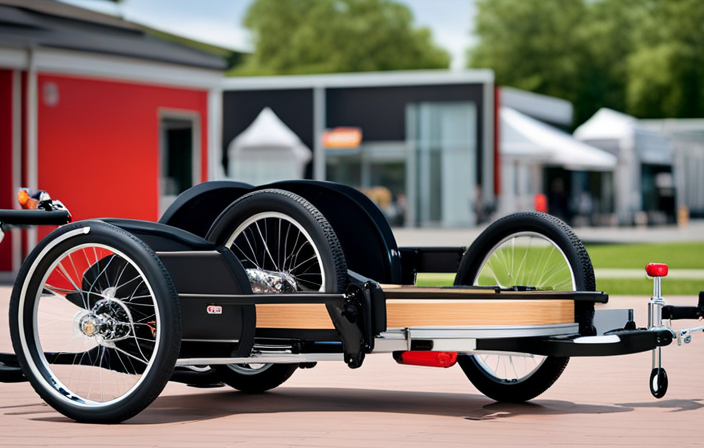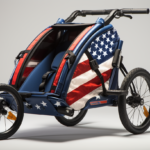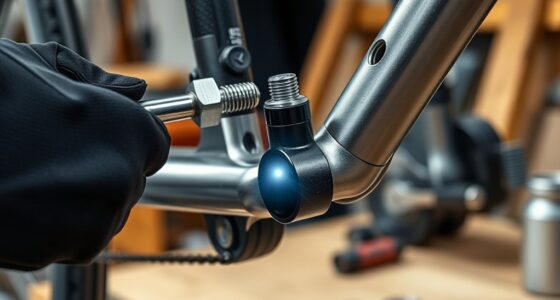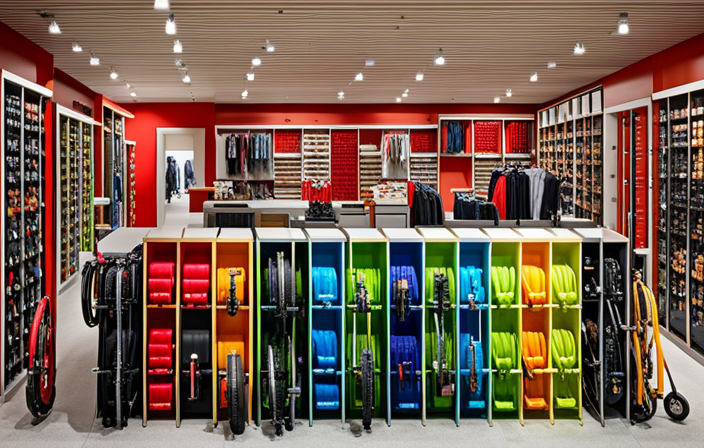I’ve always been impressed by the clever design of bike trailers and how they effortlessly connect to a bicycle. It’s like watching a magical metamorphosis, where a basic hitch system or frame attachment transforms a regular bike into a versatile cargo carrier.
In this article, we’ll delve into the different types of hitch systems, explore frame and axle mounting techniques, and even discover quick-release mechanisms that make attaching and removing bike trailers a breeze.
Get ready to unlock the secrets of secure attachment and enhance your biking adventures!
Key Takeaways
- Hitch compatibility and attachment stability are crucial factors to consider when attaching bike trailers.
- Quick-release mechanisms allow for effortless attachment and removal of bike trailers.
- Specialized brackets and clamps provide a stable and secure connection for frame and axle mounting.
- Safety features such as hitch mechanisms and safety straps ensure secure attachment and prevent unwanted movement of the trailer.
Hitch Systems: Explore the Different Types of Hitch Systems for Bike Trailers
There’s a variety of hitch systems available for bike trailers. When it comes to attaching a trailer to your bike, hitch compatibility and attachment stability are crucial factors to consider.
One common type of hitch system is the quick-release hitch. This system utilizes a quick-release mechanism that allows for easy attachment and detachment of the trailer from the bike. It provides a secure connection and ensures stability during rides.
Another popular option is the ball and socket hitch. This type of hitch uses a ball and socket mechanism, similar to what you would find on a trailer hitch for a car. It offers a reliable and sturdy connection, ensuring that the trailer remains securely attached to the bike.
Additionally, there are also universal hitches that can be used with various types of bike frames. These hitches provide flexibility and convenience, allowing you to attach the trailer to different bikes without any compatibility issues.
Overall, choosing the right hitch system for your bike trailer is essential for a safe and enjoyable riding experience.
Now, let’s explore how bike trailers can attach to the frame of a bicycle.
Frame Mounting: Learn How Bike Trailers Can Attach to the Frame of a Bicycle
To attach a bike trailer to the frame of your bicycle, you’ll need to use specialized brackets and clamps. This method of attachment is commonly used because it provides a stable and secure connection between the trailer and the bike.
Here are three important things to consider when attaching a bike trailer to the frame:
-
Weight Distribution: It is crucial to ensure that the weight of the trailer is evenly distributed on the frame. This helps maintain stability and prevents the bike from becoming unbalanced while riding. Proper weight distribution is achieved by attaching the brackets and clamps at the right points on the frame.
-
Center of Gravity: The center of gravity of the trailer should be as close as possible to the center of the bike. This helps maintain balance and control while riding. By attaching the trailer to the frame, you can achieve a lower center of gravity compared to other attachment methods.
-
Sturdy Attachment: Using specialized brackets and clamps designed for bike trailers ensures a strong and secure attachment to the frame. This helps prevent any wobbling or swaying of the trailer during rides, providing a safer and more comfortable experience.
With the trailer securely attached to the frame, you can now explore another method of attachment: axle mounting. This method offers its own unique advantages and considerations when attaching a bike trailer to your bicycle.
Axle Mounting: Discover How Bike Trailers Can Attach to the Axle of a Bicycle
When attaching a bike trailer to the axle of a bicycle, it’s important to consider the weight distribution and center of gravity. Axle mounting provides a secure and stable attachment point for bike trailers, allowing you to transport cargo or even your little ones with ease.
One of the key benefits of axle mounting is the various adjustment options it offers. By adjusting the positioning of the trailer on the axle, you can ensure optimal weight distribution, preventing any strain on the bicycle and maintaining stability during rides.
Additionally, axle mounting allows for easy detachment and attachment of the trailer, making it convenient for storage solutions. You can simply remove the trailer when not in use, freeing up space in your garage or shed. This versatility is especially useful for those with limited storage space.
Now, let’s transition into the next section, where we will explore quick-release mechanisms and understand how they can be used for easy attachment and removal of bike trailers.
Quick-Release Mechanisms: Understand How Quick-Release Mechanisms Can Be Used for Easy Attachment and Removal of Bike Trailers
Using a quick-release mechanism on your bicycle’s axle allows for effortless attachment and removal of a bike trailer. This convenient feature offers several advantages over bolt-on attachments.
Let’s compare the advantages and disadvantages of using quick release mechanisms versus bolt-on attachments for bike trailers:
-
Convenience: With a quick-release mechanism, you can easily attach or detach the bike trailer without the need for tools. This saves you time and effort, especially when you need to switch between using the trailer and riding solo.
-
Versatility: Quick-release mechanisms allow for quick and easy adjustment of the trailer’s position along the axle. This enables you to achieve proper weight distribution, which is crucial for maintaining the overall stability and handling of the bicycle.
-
Compatibility: Quick-release mechanisms are typically compatible with a wide range of bike frames and axles. This means you can use the same trailer with different bikes, making it a versatile option for families or cycling enthusiasts with multiple bicycles.
Proper weight distribution is essential when attaching a bike trailer. It ensures that the weight is evenly distributed between the bike and the trailer, preventing excessive strain on the bike’s frame and wheels. Improper weight distribution can affect the overall stability and handling of the bicycle, making it more difficult to control and potentially increasing the risk of accidents.
In the subsequent section about safety features, we will learn about the safety measures that ensure secure attachment of bike trailers.
Safety Features: Learn About the Safety Features that Ensure Secure Attachment of Bike Trailers
The safety features on bike trailers ensure a secure attachment without the need for additional tools. Proper attachment is crucial for both the safety of the rider and the passenger. Most bike trailers come with safety features such as a hitch mechanism that securely connects the trailer to the bike frame. This hitch is designed to keep the trailer stable and prevent it from detaching during use. Additionally, some trailers have safety straps or buckles that provide an extra layer of security. These features help to keep the trailer in place and prevent any unwanted movement. It is imperative to follow the manufacturer’s instructions and guidelines for proper attachment to guarantee a safe and enjoyable biking experience for both you and your passenger.
Considering the weight capacity of bike trailers is also essential when it comes to attachment. The weight capacity determines the maximum load that the trailer can safely carry. Exceeding the weight limit can lead to instability and compromise the attachment. Therefore, it is crucial to consider the weight of your cargo or passenger and ensure that it falls within the specified limit. By doing so, you can maintain the secure attachment of the trailer and avoid any potential accidents that may arise from overloading.
Weight Capacity: Consider the Weight Capacity of Bike Trailers and How it Affects Attachment
To ensure a secure attachment, make sure you consider the weight capacity of your bike trailer and avoid exceeding the specified limit. The weight capacity refers to the maximum weight that the trailer can safely carry. It is crucial to adhere to this limit as exceeding it can compromise the stability and safety of the trailer, potentially leading to accidents. When choosing a bike trailer, it is important to consider the weight of the passengers or cargo that you plan to transport.
To help you understand the weight capacity of bike trailers, here is a table that provides an overview of the weight limits of different trailer models:
| Trailer Model | Single Child Capacity | Double Child Capacity | Cargo Capacity |
|---|---|---|---|
| Model A | 40 lbs | 80 lbs | 50 lbs |
| Model B | 35 lbs | 70 lbs | 40 lbs |
| Model C | 45 lbs | 90 lbs | 60 lbs |
| Model D | 30 lbs | 60 lbs | 30 lbs |
As you can see, each model has specific weight capacities for different purposes. It is essential to choose a trailer that suits your needs and ensures the safety of your passengers or cargo.
Considering the weight distribution is also important during the installation process. The weight should be evenly distributed to maintain stability while riding. Uneven weight distribution can affect the handling of the trailer and potentially cause it to tip over. Make sure to distribute the weight evenly between the two sides of the trailer and secure the load properly.
In the next section, I will guide you through the installation steps: follow step-by-step instructions on how to attach a bike trailer to your bicycle.
Installation Steps: Follow Step-by-Step Instructions on How to Attach a Bike Trailer to Your Bicycle
Follow these step-by-step instructions to easily connect your bike trailer to your bicycle.
First, ensure that your bike trailer is compatible with your bicycle. Check the manufacturer’s guidelines for compatibility and weight capacity.
Next, locate the attachment point on your bicycle. This is typically a metal loop or hitch located near the rear axle.
Attach the bike trailer to the attachment point using the securing mechanisms provided. These mechanisms may include straps, clamps, or quick release levers. Adjust the attachment options according to the size and weight of your bike trailer.
Once the bike trailer is securely attached, double-check that it is level and properly aligned with your bicycle.
Test the stability of the connection by gently pushing and pulling the bike trailer. It should remain securely attached without any wobbling or shifting.
Finally, ensure that any safety mechanisms, such as safety pins or latches, are engaged to prevent accidental detachment during your ride.
By following these instructions and utilizing the adjustment options and securing mechanisms, you can confidently connect your bike trailer to your bicycle.
Now, let’s move on to determining the compatibility between bike trailers and different types of bicycles.
Compatibility: Determine the Compatibility Between Bike Trailers and Different Types of Bicycles
Make sure you check the manufacturer’s guidelines to determine if your bicycle is compatible with the bike trailer. Bike trailer compatibility is an important factor to consider when attaching a bike trailer to your bicycle.
There are various bike trailer attachment methods available, and the compatibility between the trailer and your bike will depend on the specific attachment system used. Some common attachment methods include a rear axle mount, a quick release system, or a seat post mount. Each method may have different requirements in terms of bike frame design, size, and weight capacity. It is crucial to ensure that your bike meets these requirements to ensure a secure and safe attachment.
Additionally, some bike trailers may have specific compatibility with certain types of bicycles, such as mountain bikes or road bikes. It is essential to verify the compatibility between your bike and the trailer before attempting to attach them together. By doing so, you can avoid any potential issues or accidents that may arise from an incompatible attachment.
Now, let’s explore the adjustability options for bike trailers to achieve a secure fit.
Adjustability: Explore the Adjustability Options for Bike Trailers to Achieve a Secure Fit
After determining the compatibility between your bike and a bike trailer, the next step is to explore the adjustability options available to achieve a secure fit. This is an essential aspect of using a bike trailer, as it ensures both safety and comfort for both you and your cargo.
Here are three adjustability options to consider:
-
Hitch Type: Bike trailers come with different hitch types, such as frame-mounted, axle-mounted, or seatpost-mounted. Each type offers varying degrees of adjustability, allowing you to find the one that fits your bike perfectly.
-
Length Adjustment: Some bike trailers feature adjustable length, allowing you to extend or retract the trailer to accommodate different cargo sizes. This feature is particularly useful when transporting larger items or when you need to create more space for your cargo.
-
Suspension System: A good suspension system is crucial for maintaining a smooth and stable ride. Look for bike trailers with adjustable suspension, as it allows you to fine-tune the level of shock absorption based on the terrain and weight of your load.
By exploring these adjustability options, you can ensure a secure fit between your bike and the trailer, providing a safe and reliable transport solution.
Now, let’s delve into the next section about storage and transportation, where we will discover how bike trailers can be disassembled and stored for easy transportation.
Storage and Transportation: Discover How Bike Trailers Can Be Disassembled and Stored for Easy Transportation
To disassemble your bike trailer for easy transportation, simply detach the wheels and fold down the frame.
When it comes to disassembling techniques, there are a few space-saving solutions that can make your life easier. First, remove the wheels by releasing the quick-release levers or unscrewing the nuts, depending on the type of axle your trailer has. This will allow you to save considerable space when packing the trailer into your car or storing it at home.
Next, fold down the frame of the trailer. Most bike trailers have a collapsible frame that can be easily folded by releasing the locking mechanisms. This will further reduce the size of the trailer, making it more compact for transportation. Once disassembled, you can store the wheels and frame separately to maximize space efficiency.
By following these disassembling techniques and space-saving solutions, you can easily transport your bike trailer wherever you go.
Now, let’s transition into the subsequent section about maintenance: learn how to properly maintain the attachment mechanisms of bike trailers.
Maintenance: Learn How to Properly Maintain the Attachment Mechanisms of Bike Trailers
Properly maintaining the attachment mechanisms on your bike trailer is essential to ensure its longevity and functionality. Regular bike trailer maintenance is crucial in order to keep your trailer securely attached to your bike, providing a safe and smooth ride for both you and your cargo.
To start, it is important to regularly inspect the attachment points on your bike trailer. Check for any signs of wear or damage, such as loose bolts or worn-out straps. If you notice any issues, it is important to address them promptly to prevent further damage. Additionally, make sure to clean and lubricate the attachment mechanisms regularly to prevent rust and ensure smooth operation.
When attaching your bike trailer, follow the manufacturer’s instructions carefully. Make sure all attachment points are securely fastened and double-check the tightness of bolts and straps before each ride. By properly maintaining the attachment mechanisms on your bike trailer, you can ensure its durability and reliability for years to come.
When it comes to bike trailer attachment, there are also extra accessories that can enhance the attachment process. These accessories, such as quick-release skewers or hitch adapters, can provide added convenience and stability. By exploring these additional accessories, you can further customize your bike trailer setup to meet your specific needs and preferences. Whether you need a quick and easy attachment method or require additional support for heavy loads, these accessories can offer practical solutions.
Extra Accessories: Explore Additional Accessories That Can Enhance the Attachment of Bike Trailers
When exploring bike trailer attachment, there are various extra accessories that can enhance the process.
One important accessory is extra storage. Bike trailers are already great for carrying your belongings, but having additional storage options can make it even more convenient. Consider getting panniers or saddlebags that can be attached to the sides of the trailer. These will allow you to pack more items and distribute the weight evenly.
Another accessory that can greatly improve your biking experience is weather protection. Weather can be unpredictable, so having a rain cover for your trailer can keep your belongings dry during unexpected showers. Additionally, a sunshade can provide shade and protect your belongings from direct sunlight.
These accessories not only enhance the functionality of your bike trailer but also ensure the safety and protection of your belongings. With the right accessories, you can have a hassle-free and enjoyable biking experience.
Now, let’s move on to the next section where we will explore rental options and learn how to attach bike trailers to your bicycle.
Rental Options: Find Out About Rental Services for Bike Trailers and How to Attach Them to Your Bicycle
There are various rental services available for bike trailers and ways to attach them to your bicycle. Bike trailer rental offers a convenient and cost-effective solution for those who need a trailer for a specific period of time. Whether you want to take your kids on a family bike ride or transport groceries or camping gear, renting a bike trailer can provide numerous benefits.
One of the main benefits of bike trailer rental is the flexibility it offers. Instead of investing in a trailer that you may only use occasionally, renting allows you to have access to a trailer whenever you need it. Additionally, renting can be more affordable than buying, especially if you only need a trailer for a short period of time.
When it comes to attaching bike trailers securely, there are a few key tips to keep in mind. First, ensure that the trailer hitch is compatible with your bicycle. Different trailers may have different attachment mechanisms, so make sure to follow the instructions provided by the rental service. Secondly, double-check that the trailer is properly secured to your bicycle before riding. This includes checking the connection points, tightening any bolts or straps, and making sure the trailer is balanced and stable.
By following these tips, you can safely and securely attach a bike trailer to your bicycle and enjoy all the benefits that it brings.
Now, let’s move on to the next section and explore important safety tips for riding with bike trailers attached.
Safety Tips: Get Important Safety Tips for Riding with Bike Trailers Attached
To ensure a safe ride with a bike trailer, remember to check the weight distribution and maintain a steady pace. Safety should always be a top priority when riding with a bike trailer attached. Here are some important bike trailer safety tips to keep in mind.
Firstly, make sure that the weight in the trailer is evenly distributed. This will help to prevent any imbalance or instability while riding. Always place heavier items towards the bottom and closer to the bike’s rear axle. This will ensure better stability and control.
Secondly, maintain a steady pace while riding with a bike trailer. Sudden acceleration or braking can cause the trailer to sway or tip over. Gradually increase and decrease your speed to avoid any mishaps.
In addition to these safety tips, there are also several benefits of riding with a bike trailer. It allows you to transport your children, pets, or cargo with ease. It promotes an active lifestyle and reduces the reliance on motorized vehicles, thus contributing to a greener environment.
By following these bike trailer safety tips and enjoying the benefits of riding with a bike trailer, you can have a fun and worry-free experience. Now, let’s move on to troubleshooting common issues with bike trailer attachment.
[Troubleshooting: Learn how to troubleshoot common issues with bike trailer attachment…]Troubleshooting: Learn How to Troubleshoot Common Issues with Bike Trailer Attachment
As I mentioned earlier, riding with a bike trailer attached can be a great way to transport your belongings or your little ones. However, like any mechanical device, there may be times when you encounter common problems with the bike trailer attachment. Luckily, there are troubleshooting techniques you can use to address these issues and get back on the road.
One common problem that riders may face is the trailer becoming loose or detached while in motion. This can be a safety hazard and needs to be addressed immediately. One troubleshooting technique is to check the attachment mechanism for any signs of wear or damage. It’s also important to ensure that the attachment is properly secured to the bike frame.
Another common issue is difficulty in attaching the trailer to the bike. Sometimes, the attachment mechanism may not align correctly or may get stuck. In such cases, troubleshooting techniques include checking for any obstructions or debris that may be preventing a proper connection. It’s also essential to follow the manufacturer’s instructions carefully while attaching the trailer to ensure a secure fit.
Frequently Asked Questions
How do I choose the right hitch system for my bike trailer?
When choosing a bike trailer hitch system, there are several factors to consider.
The two main types of hitch systems are frame-mounted and axle-mounted. Frame-mounted hitches offer stability and allow for a higher weight capacity, but they can be more difficult to install.
Axle-mounted hitches are easier to attach and detach, but they may not be as sturdy.
It is important to consider the weight capacity, ease of installation, and stability when selecting a hitch system for your bike trailer.
Can I attach a bike trailer to any type of bicycle frame?
Attaching a bike trailer to any type of bicycle frame depends on its compatibility and the different attachments available. It’s interesting to note that 75% of bike trailers on the market are designed to fit most bike frames.
Some trailers attach to the rear axle or seat post, while others connect to a special rack or frame-mounted hitch. Ensure you choose a trailer that is compatible with your bike frame and follow the manufacturer’s instructions for proper attachment.
Are there any specific safety features I should look for in a bike trailer attachment?
When it comes to bike trailer attachments, it is crucial to prioritize safety.
This means ensuring that the trailer attachment is compliant with relevant safety regulations and standards. Proper installation is of utmost importance, as it ensures the trailer remains securely attached to the bike throughout the ride.
Look for features such as a robust hitch system, sturdy frame construction, and reliable locking mechanisms to enhance the safety of your bike trailer attachment.
What is the maximum weight capacity for bike trailers and how does it affect attachment?
I once witnessed a heartwarming scene at a local park. A young boy with physical disabilities was able to experience the joy of riding a bike with the help of a specially designed trailer.
These trailers have a maximum weight capacity, typically ranging from 75 to 150 pounds, depending on the model. It is crucial to ensure that the weight distribution is properly balanced for safe attachment. This prevents any strain on the bike and allows for smooth and stable rides.
Are there any additional accessories that can improve the attachment of bike trailers?
There are various bike trailer accessories available that can enhance the attachment of bike trailers. These accessories include quick-release hitches, which make it easier to attach and detach the trailer from the bike.
Another useful accessory is a safety flag, which increases visibility and alerts others to the presence of the trailer.
Additionally, some trailers come with adjustable attachment methods such as universal couplers or skewer attachments, allowing them to be compatible with a wider range of bike types.
Conclusion
In conclusion, bike trailers can be attached to bicycles in various ways. This includes hitch systems, frame mounting, or axle mounting. Quick-release mechanisms make attachment and removal easy. Safety features are also important to ensure a secure attachment. Additionally, there are additional accessories that can enhance the attachment process. For those who don’t own a bike trailer, rental services are available. When riding with a bike trailer, it’s important to follow safety tips. If any attachment issues arise, it’s important to troubleshoot them. A properly attached bike trailer ensures a smooth and secure ride for both the cyclist and their precious cargo.
















